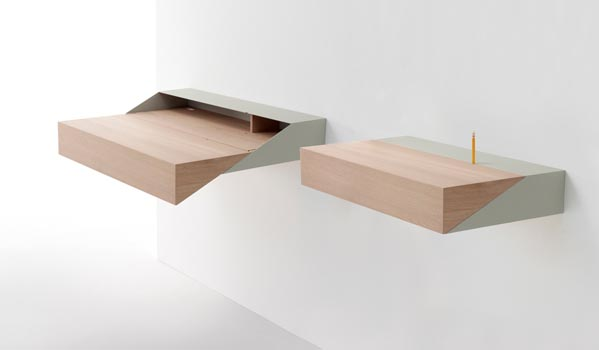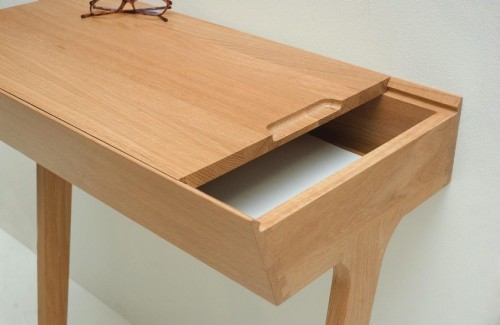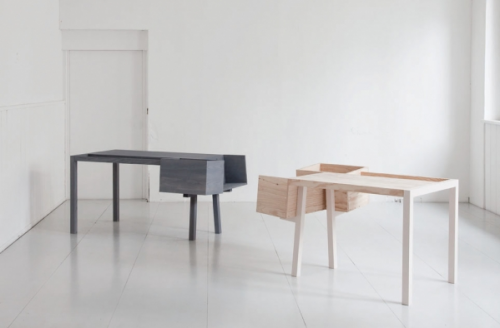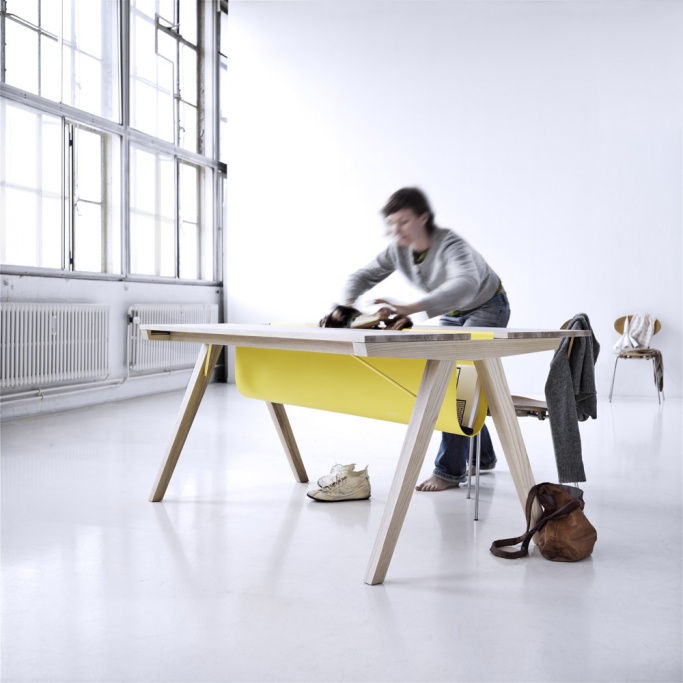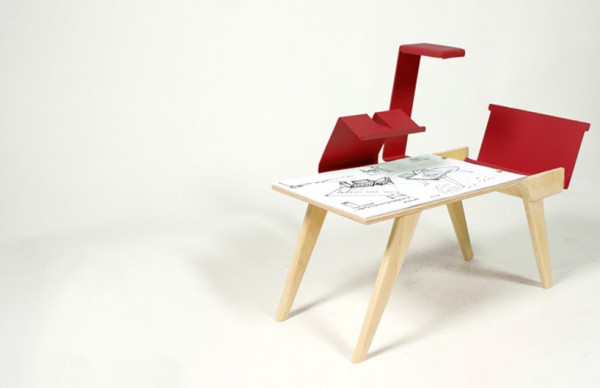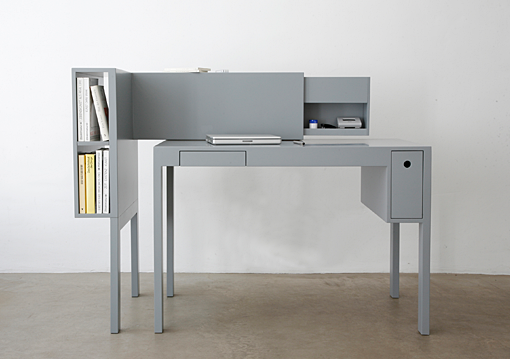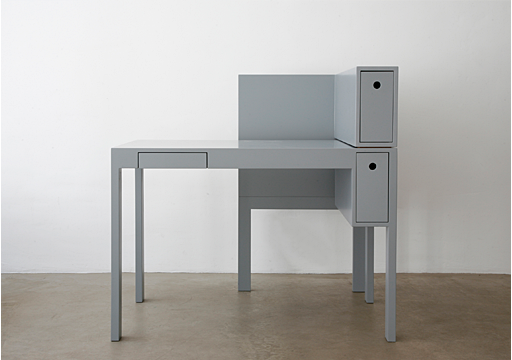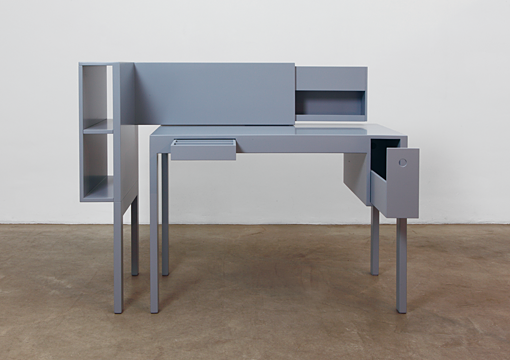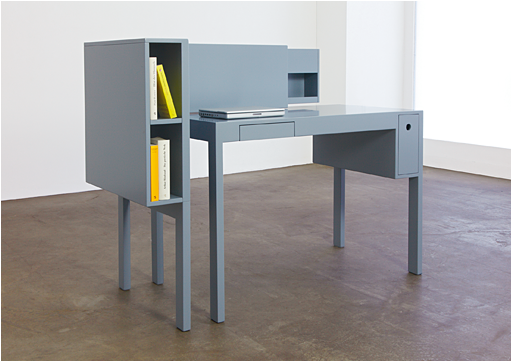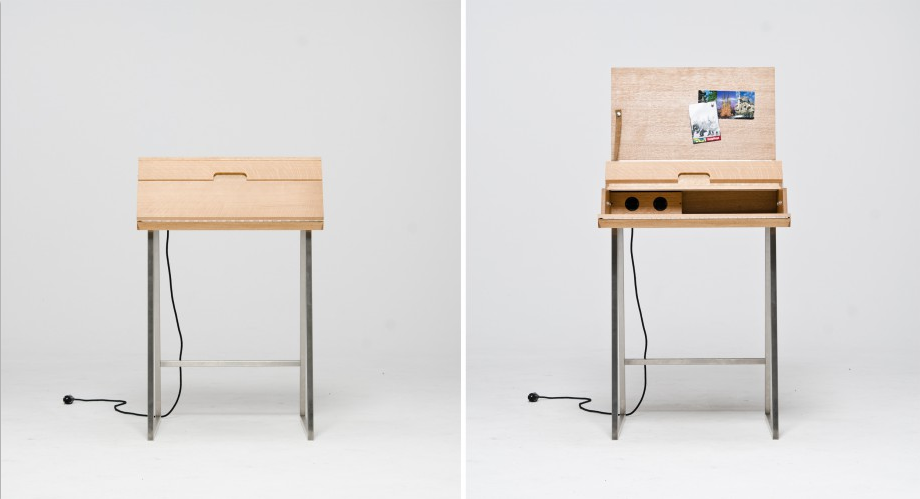
This desk by German designer Gregor Korolewicz, called Klippen Klappen, tiny in its folded state, can be unraveled to reveal a hidden storage capacity. The clever mechanism of the piece (one can compare with a sewing box) allows the parts slide both forward and backward, exposing three compartments: a tray for laptop, a shallow storage container and a box for writing paraphernalia. The lid can be used as a bulletin board and display notes and pictures. Every essential and beyond… The piece even plugs into the wall and offers two outlets for workplace devices.
(via leibal)

This beautiful and flexible work table is a creation of Spanish designer Tomás Alonso. The piece is built to host a set of accessories – different lamps and dividers – that can be customized by the user. Here is how Alonso describes it: “The project explores the idea of the work table as a microsystem with separate elements that can be combined into an array of possibilities. An object of common use, the table is broken down into its basic components to which a series of functional accessories can then be added. The configuration of all these elements is left to the user who can arrive to their own solution in response to their own functional and aesthetic needs.” The frame itself can be individualized – the design of the aluminium profile used to secure the legs to the table allows for both aluminium and wooden legs, or a combination of both. Various colors and wooden finishes are also available.
(via fastcodesign)

Le Scriban is the name of this small but quite storage generous desk by Marseille based young designer Margaux Keller. The piece is a hybrid workspace and console table with built in storage and display. Leaning against the wall, the desk is minimal and light. And the clever slots for papers, books, frames and other home office items provide storage and full visibility. No more searching for things in drawers… Le Scriban desk is made of oiled solid oak.
Since we’re on the subject of desks, here is one I am truly delighted by. DeskBox by Israel-born UK-based designers Yael Mer & Shay Alkalay of Raw Edges studio, created for the furniture brand Arco, is a soaring example of elegant simplicity and clever space-saving. A practical small table/cabinet that is hung onto a wall is ideal for small apartments. It its “box” mode, the item is barely extended from the wall. But as you pull the cover down – it turns into a nicely sized workstation, sufficient for a laptop or some writing paraphernalia. The opening on the back for cables and cords and a small storage compartment complete the piece.
I believe in the virtue of small desks. Especially if our tasks are limited to writing, reading and light computing (which is usually the case for many people at home). Limited surfaces keep you organized and, if you add a clever storage hack to it, you’re set. The Quello table by British designer Phil Procter is exactly that – a tiny desk with the neat storage compartment. When not in use as a work station, Quello can serve as a console in a hallway or vestibule. Add a chair to it – and it transforms. The top of the table slides both ways allowing one to reach the storage underneath without disturbing objects on the surface. Lovely idea beautifully executed.
The Clark desk is an unusual creation of German studio Llot Llov. Unlike traditional desks, that often try to conceal storage, this one displays it for you to see at all times. The idea is to provide a comfortable nest for stacking things rather then filing them away. “Everything stays within reach and does not disappear in drawers or cupboards,” – designers explain, – The desk picks up on the most common way of keeping objects on your desk and enables to do this in a variety of ways.” This storage concept could be useful for us, visual types, who need a full view of their “work-in-progress” piles to stay focused and inspired. The piece is made of natural pine wood and comes in two finishes.
Cleaning up one’s desk is one of the most dreaded household chores. Wouldn’t it be nice to eliminate clutter in an instant or at least make it invisible? This desk by Danmark-based studio Line Depping lets you cheat and tidy up in a matter of seconds. It opens up in the middle to reveal a flexible pocket, serving as a holder for your things. And once the work-related paraphernalia is swiped away, the desk surface can be used as a dining or entertainment area. The storage pocket can also be used for cordage and electronic clutter during work time. Lovely idea!
If you humanize objects (I do), you will be delighted by this piece. Listen to Your Hands desk by Sanghyeok Lee has just won second prize in the [D3] Contest during the IMM Cologne 2012. The drawers of the desk are connected, so if you push one with force – others will respond by moving. But if you are gentle – the drawers can be operated individually, without setting other parts of the desk in motion. Designer elaborates: “Listen to Your Hands looks at the most sensitive of human senses, touch; it communicates a whole world of information to us and it explores how we can create a relationship to an object, a sort of dialogue, through touch. A push of one drawer pulls out another as if in direct conversation with the action. A gentle closing of a drawer keeps the others intact thus communicating to us that we need to act with intention, we need to listen with our hands.”
Polichinelle desk has been created by two French designers Yoann Jestin and Benoît Pernet. And just as its namesake it is colorful and fun. The idea of the piece was to free the desktop completely and allow using it solely for paper. You can cover the surface with a pad, write on it, draw on it or tear the used paper off. In order to separate the writing part of the desk from its storage, the series of removable components were created. They include a music stand (for a book or laptop), lamp, and a storage box with lid holding the pad with magnets. The components are made from thin metal and come in various colors.
Bureau by Martin Holzapfel is a handsome, Bauhausy-looking piece indeed. But what is even more attractive is how functional it is. The desk is comprised of two components – the main working area, which is only about 43 inches long and contains a drawer and a file compartment. Another component is a free-standing storage unit that can be attached to the desk from two different sides (depending on your storing needs and space requirements). Here you have two long shelving compartments and one generously sized drawer that can be used for files, papers, immediate working clutter or equipment. Beautiful idea and tremendous execution.

